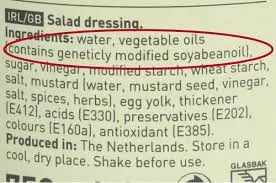In this first in a series on our food supply, I have been hearing the term GMOs referring to our foods that we eat. So I decided to do a little research and what I found is concerning.
A GMO…which stands for “genetically modified organism”, is an animal or plant with genetic material that has been altered in a lab. We’re usually talking about food we eat when we use the term “GMO.” A common reason for a company to choose to genetically modify their product is to have it withstand pesticides, or to have it naturally emit a pesticide.
Over 80% of all GMOs grown worldwide are engineered for herbicide tolerance.  As a result, use of toxic herbicides like Roundup has increased 15 times since GMOs were introduced. GMO crops are also responsible for the emergence of “super weeds” and “super bugs:’ which can only be killed with ever more toxic poisons like 2,4-D (a major ingredient in Agent Orange).
As a result, use of toxic herbicides like Roundup has increased 15 times since GMOs were introduced. GMO crops are also responsible for the emergence of “super weeds” and “super bugs:’ which can only be killed with ever more toxic poisons like 2,4-D (a major ingredient in Agent Orange).
GMOs are a direct extension of chemical agriculture, and are developed and sold by the world’s biggest chemical companies. The long-term impacts of GMOs are unknown, and once released into the environment these novel organisms cannot be recalled. Because GMOs are novel life forms, biotechnology companies have been able to obtain patents with which to restrict their use. As a result, the companies that make GMOs now have the power to sue farmers whose fields are contaminated with GMOs, even when it is the result of inevitable drift from neighboring fields. GMOs therefore pose a serious threat to farmer sovereignty and to the national food security of any country where they are grown, including the United States. To me, this seems unfair and unacceptable. One of the most common concerns about the prevalence of GMOs (genetically modified organisms) in North America is whether they are safe for our children and families to be eating.
Are my kids eating genetically engineered food?  The sad truth is many of the foods that are most popular with children contain GMOs. Cereals, snack bars, snack boxes, cookies, processed lunch meats, and crackers all contain large amounts of high risk food ingredients. In North America, over 80% of our food contains GMOs. If you are not buying foods that are Non-GMO Project Verified, most likely GMOs are present at breakfast, lunch, and dinner. Shopping organic is one of the best steps you can take towards ensuring that your family eats the healthiest foods possible. Learn more about all of the benefits of Certified Organic here.
The sad truth is many of the foods that are most popular with children contain GMOs. Cereals, snack bars, snack boxes, cookies, processed lunch meats, and crackers all contain large amounts of high risk food ingredients. In North America, over 80% of our food contains GMOs. If you are not buying foods that are Non-GMO Project Verified, most likely GMOs are present at breakfast, lunch, and dinner. Shopping organic is one of the best steps you can take towards ensuring that your family eats the healthiest foods possible. Learn more about all of the benefits of Certified Organic here.
According to the Organic Trade Association, “The use of genetically modified organisms (GMOs) is prohibited in organic products. This means an organic farmer can’t plant GMO seeds, an organic cow can’t eat GMO alfalfa or corn, and an organic soup producer can’t use any GMO ingredients. To meet the USDA organic regulations, farmers and processors must show they aren’t using GMOs, and that they are protecting their products from contact with prohibited substances, such as GMOs, from farm to table.” The rigorous requirements of the National Organic Program help to prevent GMO contamination of organic foods.
I will continue this series on “What’s Happening to Our Food? In my next post. Feel free to leave comments and remember to hit the “Like” button at the bottom of this post.






